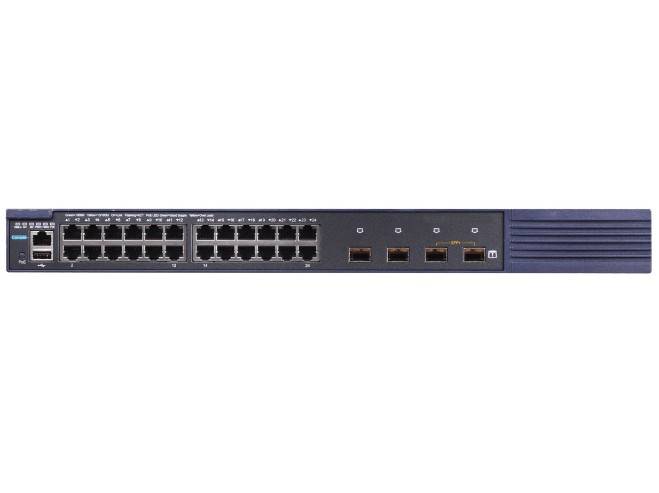



Full gigabit access to local area networks in large enterprise parks, and gigabit access to commercial systems
Product characteristics:
Green and energy-saving, saving 40% power consumption compared to products of the same grade
Equipped with the multi-process modular RGOS 11. X operating system developed by Anpson
Fully supports SDN features and complies with Openflow 1.3 protocol standards
Support TR069 zero configuration online; Rich and diverse port configuration options
Flexible scalability
All SFP+and SFP ports of AP-G1110H-24 series products can be fully downwardly compatible with lower level optical interface modules; The PoE model supports the standard 802.3af and 802.3at remote power supply standards, provides modular dual power supplies, and can support full load power supply for all downstream ports PoE+; At the same time, it is equipped with a different number of expansion slots, which can flexibly expand different numbers of 10 Gigabit optical ports according to user needs, and completely customize the exclusive configuration according to user usage scenarios.
Perfect security protection strategy
ARP viruses or attacks are the most common and influential type of attacks in networks. The AP-G1110H-24 series switch supports multiple modes of ARP spoofing prevention functions. Regardless of whether the user automatically obtains an address through a DHCP server or uses a fixed IP address, the AP-G1110H-24 series can record the user's true IP+MAC address, and when the switch port receives the ARP message sent by the host, it compares the ARP message content with the recorded IP+MAC address, and only forwards the ARP message with the true content, Discard fake ARP packets to shield ARP spoofing from the network and protect network users from ARP virus attacks.
Actively defend against various DDOS attacks in the network. Due to the openness of the network, computers are often infected with viruses, or personnel accessing the network attack network devices and servers for various purposes, resulting in the network being unable to function properly. More common examples include ARP flooding attacks that cause gateways to fail to respond to requests, ICMP flooding attacks that cause network equipment CPU loads to be too high to function properly, and DHCP request flooding attacks that cause DHCP server addresses to dry up and users to be unable to obtain IP addresses to access the network normally.
The AP-G1110H-24 series provides the industry's advanced hardware CPU protection mechanism: a unique CPU Protection Policy (CPP) that performs flow differentiation and priority queue hierarchical processing for data flows sent to the CPU, and implements bandwidth speed limits as needed to fully protect the CPU from illegal traffic, malicious attacks, and resource consumption, ensuring CPU security and fully protecting the security of the switch.
The AP-G1110H-24 series provides advanced Network Foundation Protection Policy (NFPP) technology, which can limit the rate at which users send ARP messages, ICMP request messages, DHCP request messages, and other data packets to the network, discard messages that exceed the speed limit threshold, and even identify attacks and isolate users with attacks. Thereby protecting the basic network from the impact of network attacks and ensuring network stability.
DHCP snooping is supported, allowing only DHCP responses from trusted ports to prevent spoofing by private DHCP servers; Based on DHCP monitoring, through dynamic monitoring of ARP and checking the user's IP address, illegal messages that do not comply with binding table entries are directly discarded, effectively preventing ARP spoofing and user source IP address spoofing.
Virtual Switching Unit (VSU)
AP-G1110H-24 series products support Virtual Switching Unit (VSU). The ability to interconnect multiple physical devices and virtualize them into a single logical device, utilizing features such as a single IP address, a single Telnet process, a single command-line interface (CLI), automatic version checking, and automatic configuration for management. For users, it is just managing one device, but it achieves the efficiency and experience brought about by multiple devices.
Simplified management: Administrators can uniformly manage multiple switches without having to connect to each switch for configuration and management.
Simplify network topology: VSU is equivalent to a switch in the network, connected to peripheral devices through aggregation links. There is no two-layer loop, and there is no need to configure the MSTP protocol. Various control protocols operate as a switch.
Millisecond level fault recovery: VSUs and peripherals are connected through aggregated links. If one device or one member link fails, the time to switch to the other member link only takes 50 to 200 milliseconds.
High scalability: When users add new devices to or leave the virtualized network, they can achieve "hot swapping" without affecting the normal operation of other devices.
Protection investment: VSUs and peripherals are connected through aggregated links, providing both redundant links and load balancing, making full use of all network equipment and bandwidth resources. At the same time, a VSU virtual network system can be formed using any form of 10 gigabit port through any data transmission cable. There is no need to configure additional cables and expansion cards, and there are no restrictions on ports and cable types, maximizing the protection of user investment.
High reliability
Support spanning tree protocols STP, RSTP, and MSTP to ensure fast convergence, improve fault tolerance, ensure stable network operation, and load balance of links. Reasonably use network channels, and provide redundant link utilization.
Support Virtual Router Redundancy Protocol (VRRP) to effectively ensure network stability.
Support for the Rapid Link Detection Protocol (RLDP), which can quickly detect the on-off of links and the unidirectionality of optical fiber links, and support the loop detection function under the port to prevent network failures caused by loops formed by devices such as private hubs under the port.
Support for public Ethernet multi ring protection technology (ERPS), a two-layer link redundancy backup protocol designed according to international standards for core Ethernet. Its loop blocking and link recovery are centralized on the master device. Non master devices directly report their link conditions to the master device, without requiring processing by other non master devices. Therefore, loop interruption and recovery times are faster than STP. Based on the above differences, the link recovery capability of ERPS in an ideal environment can reach millisecond level.
When STP is not enabled, a fast uplink protection function can be provided through the Rapid Link Detection Protocol (RLDP). REUP allows users to provide basic link redundancy even when STP is turned off, while providing faster nanosecond fault recovery than STP.
Software Defined Network (SDN)
The AP-G1110H-24 series products follow the development of the times and fully support OpenFlow 1.3. They can cooperate with Anpson's self-developed SDN controller to easily achieve large-scale two-layer architecture networking, and support the smooth upgrade of the entire network to SDN networks, greatly simplifying the difficulty of network management while significantly reducing the cost of network maintenance.
Green and energy-saving
The AP-G1110H-24 series switches fully respond to the national call for green energy conservation, adopt a variety of green energy conservation design concepts, and conduct in-depth research and exploration on the problems existing in traditional switches in terms of noise and energy consumption, fully solving the problems of high noise in the office environment and excessive energy consumption caused by large-scale deployment of access equipment.
The AP-G1110H-24 series switch adopts a new generation of hardware architecture, advanced energy-saving circuit design, and component selection. The overall power consumption of the device has been reduced by more than 40%, which greatly saves energy consumption for users and reduces noise pollution. The entire series of products are designed with axial flow variable speed fans. The equipment can intelligently control the fan speed based on the current temperature, ensuring stable operation of the equipment, while reducing power consumption and noise.
In the PoE power supply networking environment, the AP-G1110H-24 series products provide automatic mode, energy-saving mode, and static mode for users to choose based on the actual needs of different users.
The AP-G1110H-24 series switch supports Efficient Energy Efficient Ethernet (EEE). If the port is idle for a continuous period of time, the system will set the port to an energy saving mode. When there are messages to be sent and received, the port will be awakened to resume service through a regularly transmitted monitoring code stream, achieving the effect of energy conservation.
AP-G1110H-24 series products simultaneously meet the EU RoHS standards for environmental protection and safety of materials, and meet national certification requirements such as SJ/T 11363/11364/11365.
Simple and easy network maintenance
The AP-G1110H-24 series supports features such as SNMP, RMON, Syslog, sFLOW, and USB backup logs and configurations for daily network diagnosis and maintenance. At the same time, administrators can adopt diverse management and maintenance methods such as CLI, Web network management, Telnet, and CWMP (TR069) zero configuration to facilitate device management.
The PoE usage status is clear at a glance: The panel comes with a PoE button that allows you to view the current communication status and power supply status of the device with a single click, allowing you to have a clear understanding of the PoE power supply status of all ports.
 扫描微信 关注我们
扫描微信 关注我们

24小时服务热线800-228-9375

联系电话0591-83057373
Copyright © 2023 Anpson Technology Co., Limited. All Rights Reserved. 采购办事处:28/F, Juyuanzhou Industrial Park, Jinshan Avenue, Cangshan District, Fuzhou City, Fujian, China 粤ICP备08254615号